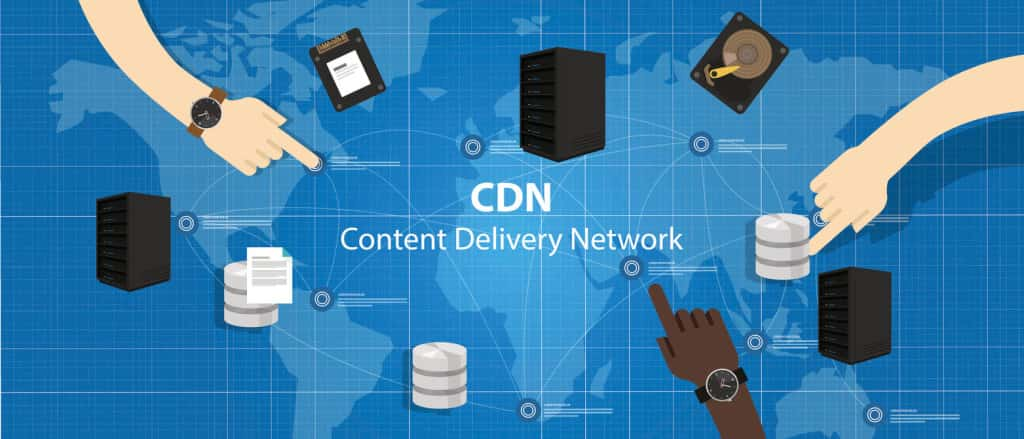The Broadcaster’s Guide to CDNs (Content Delivery Networks)
Delivering top-tier online video can be challenging. Content files are getting larger and users expect HD streaming to happen instantly. Broadcasters who value quality are incorporating live streaming CDNs (content delivery networks) to meet this growing demand.
The modern Web is a mixture of text, images, audio, and video with data centers around the world supplying information on a 24/7 basis. However – as the Internet gets more congested – streaming performance suffers and end-users grow frustrated.
To combat this problem, organizations are turning to CDNs to provide greater bandwidth, reliability, and security for their content and websites. Used extensively by social media networks, entertainment companies, e-commerce brands, and enterprise businesses, CDNs quickly (and reliably) serve content to users around the world.
Today, we are going to break down what a CDN is, how they work, and why they matter to broadcasters. We are also going to discuss how content delivery networks improve live streaming/video on demand and enhance the online viewing experience. We will wrap up by comparing a few of the top CDN providers and giving our recommendations for getting started with content delivery networks.
Table of Contents:
- What is a CDN (Content Delivery Network)
- How do CDNs work
- What are the Advantages of using a CDN
- Why are CDNs Important?
- Content Distribution Networks and Business Growth
- How do CDNs Improve Live Streaming
- Comparing CDN Network Providers
Here’s a little something to think about: studies show that by 2022, 72% of all web traffic will cross a CDN. While this statistic may be hard to comprehend, it raises an interesting point. If you plan to share high-quality video content around the world, you need a reliable content delivery network. After reading on, you’ll know why.
What Is A CDN (Content Delivery Network)?


As the name implies, content delivery networks are collections of high-end media servers designed to share files with large audiences. These systems maintain copies of static web files to reduce the load on hosting servers and improve data transfers.
CDNs are computer collections strategically placed in data centers around the world. These synced, mesh content networks provide faster response times and make content delivery more efficient. You may not realize it, but most of us interact with CDNs on a daily basis.
Media and news outlets, e-commerce sites, sports teams, and entertainment brands all use content delivery networks for file delivery. Enterprise organizations like Apple, Microsoft, and Amazon even have their own internal CDNs to manage operations and provide client services.
CDNs can also better accommodate fluctuations in web traffic and minimize the risk of failure from a single system or network. We’ll talk more about that in a moment.
How Do CDNs Work?


Organizations can enlarge their digital footprint, serve bigger audiences, and improve user experiences – without requiring major infrastructure upgrades or additional staff.
Normally, clients access content by communicating directly with a video hosting server. Visitors indicate what they want, and the server delivers the goods. While this works fine on a small scale, problems arise as website traffic grows or user locations expand.
Over time, the hosting server starts to bog down (degrading performance). Until eventually – with enough requests – the site falters or crashes.
Even if the server holds up under heavy loads, distance plays a critical role as well.
Most internet data is routed via high-speed fiber optic cable. Although an advanced transmission medium, fiber still has limitations. For every kilometer of distance added, latency (or signal delay) increases by 3.33 µs. No big deal for local connections but sending files to the other side of the globe is a different story.
Depending on the total distance covered – and the bandwidth of the remote user – site experiences can differ vastly. This is why CDNs were created.
CDN Architecture


CDNs utilize both origin servers and edge servers to provide content delivery.
Origin servers – function as the primary source of website data. These are typically the main servers assigned to you by your hosting provider. Although robust machines in their own right, their capacity for serving files is still limited.
Edge Servers – secondary devices strategically located around the globe. Edge servers store “cached” static content from origin servers and mimic their responses to inbound requests.
These devices are also known as PoP (Point of Presence) servers. PoP can also refer to the geographic location where the server resides. Meaning, there may be more than one edge server at each PoP datacenter.
To access content, user requests are first sent to local DNS servers which then forward these inquiries to the nearest edge server. If the data is found, the PoP device delivers the requested media.
If the resource is not found, the request is sent to the origin server. Afterward, the edge server downloads the file and sends it to the user. Eventually, as the edge server continues to cache more content, fewer requests are sent to the origin server.
Thus, reducing the origin server load, minimizing connection latency, and improving video streaming performance.
Complex algorithms use factors such as speed, proximity, and server availability to determine which edge device users connect to. Edge servers also continually “talk” to one another and perform load balancing to ensure user requests are served efficiently and with minimal disruption.
It’s worth noting that CDNs are NOT the same as hosting providers.
Organizations still need to partner with a host platform to set up their website and create file shares. CDN’s simply work in conjunction with video hosting platforms to improve bandwidth, increase security, and help prevent downtime.
What Are the Advantages of Using a CDN?
Content delivery networks provide a number of technical advantages for broadcasters, but there are other benefits as well. Here are a few examples.
For end-users, enjoying a seamless content delivery experience is the ultimate goal. Audiences want to download information quickly without delay or interruptions. Providing content that can be reliably streamed from any device (or location) is key for business growth and brand reputation.
Since CDNs store copies of the same media on global servers, a strong connection is always within reach. Response times improve and user satisfaction remains high.
For website owners, employing multiple servers means less network overhead and reduced costs. Since bandwidth loads are distributed amongst multiple devices, the chances of a system failure are significantly reduced.
If one server goes offline, another picks up the slack.
Maintenance costs are lower also. Organizations don’t need to increase hosting services or buy more powerful servers to meet higher demand. Instead, they can distribute content to additional CDN data centers.
Scalability is never an issue as extra PoP servers can be added (or removed) as needed.
Content Distribution Networks and Business Growth


Sharing content from multiple data centers provides a superior user experience.
For example, say you’re in Boston and request a video file from a London server. That data has to travel across the Atlantic Ocean and back to get to you. Even with today’s high-powered transmission cables, there is still latency. However, by adding an additional data center in New York, the transfer delay is significantly reduced.
Studies show that every second of latency reduces website conversions by 7%. Furthermore, nearly 50% of consumers expect a page to load in two seconds or less. Clearly, speed matters. And not just when it comes to visitor satisfaction.
Speed is also a primary ranking factor of SEO (Search Engine Optimization). Site and content assets that load faster see higher conversion stats and lower bounce rates.
Employing CDNs improves available bandwidth and helps deliver content faster.
Use Cases
While big businesses and CDNs are a natural fit, so are many other verticals and organizations. Education providers can use content delivery networks to share classroom material (video lectures, slide shows, presentations, etc.) with students everywhere. CDNs help educators expand their reach and provide quality experiences to students regardless of their location.
Media and advertising agencies can use CDNs to push content faster and more reliably to larger audiences. Efficiently delivering high-quality content (at scale) is critical for media-based organizations.
Even churches and worship centers can benefit from using content delivery networks to live stream services and create video on demand libraries. CDNs amplify their message and allow these organizations to reach new audiences around the world.
Why Are CDNs Important?
We briefly mentioned some advantages of utilizing CDN networks, but let’s take a closer look. Namely, in the areas of speed, reliability, and security. All of which are core elements of a reliable video delivery platform.
Speed


Even if visitors don’t abandon the site, a bad experience makes it unlikely they will return. Yet, this is exactly what happens if web hosting computers get overloaded.
When too many users contact the origin server at the same time, performance slows to a crawl. Users get frustrated and websites lose visitors. CDNs minimize these problems as they take the load of the origin server and redistribute it to edge devices.
Reduced latency (delay) results in better video performance and higher quality.
More speed also prevents packet loss – the condition where some data traveling between endpoints is lost (and has to be resent). Longer transmission paths, through more equipment, with differing hardware and bandwidth speeds, can be a major source of packet loss.
Based on how far a request needs to travel, latency and packet loss can really add up. Imperfections in fiber optic cables and substandard hardware devices can also degrade connections and add to existing latency issues.
CDNs use the “superhighways” of the Internet to maximize transfer rates.
Content delivery networks are strategically located to shorten distances between hosts and users. These data centers also employ advanced hardware technology to stream data as quickly as possible with minimal lag or delay.
Not to mention being staffed by seasoned tech support personnel if problems arise.
Reliability
Beyond blazing speed, content delivery networks also increase reliability. Rather than depending on a single server or network, CDNs include redundant data servers all around the world. If one goes down, the rest pick up the slack (and users are none the wiser).
CDNs handle traffic spikes better – whether from malicious attacks or boosts in engagement. When a surge of traffic hits, the load is distributed evenly amongst data centers in the network. This protects the origin (hosting) server and keeps your site running smoothly – even when demand fluctuates.
Depending on the hosting provider and plan you choose, this benefit alone can be a huge differentiator. Smaller hosting vendors cannot handle large traffic surges as well as CDNs because their infrastructure just isn’t built to support it.
CDNs also keep costs down since you don’t need to upgrade your hosting plan as your bandwidth needs to grow. The CDN throughput expands to match your requirements.
Improved Security
One of the biggest security concerns of delivering content is preventing DDoS (Distributed Denial of Service) attacks. DDoS attacks happen when a website is flooded by millions of fraudulent data requests. This sudden surge of traffic overloads hosting servers and causes them to fail.
Research shows DDoS attacks are on the rise and show no signs of slowing down. Thus, preventing them (and securing your network) are essential for content delivery.
CDNs mitigate DDoS attacks by eliminating single points of failure.
With large data centers strategically located around the world, compromising one or two PoP servers does not severely impact the others. Affected computers can be quickly repaired and put back into service. Usually, before visitors even know.
CDNs also facilitate creating SSL connections between client devices and edge servers. Which bolsters network security and helps prevent additional attacks.
Lastly, world-class tech support is included. Rather than relying on internal IT staff to solve problems, you gain a vendor army to maintain server uptime and reliability.
All for a single monthly price with the exact features your business needs.
How Do CDNs Improve Live Streaming?


CDNs enhance live streaming experiences by quickly delivering content (at scale).
As we explained, one of the biggest challenges with sending content over large distances is packet loss. This issue is especially problematic for live streaming video as data is sent “packet by packet” in real-time. Any loss (above a minimum threshold) can reduce performance and downgrade quality for subscribers.
Adding CDN capabilities to your live streams significantly reduces packet loss. Employing worldwide distribution servers means a fast, reliable connection (and plenty of bandwidth) is always available to meet user demand.
Consider this: marketing research finds that 80% of viewers would rather watch live video than read a blog and 82% prefer video to social posts.
67% of online viewers say that quality is the most important aspect of live stream content.
And with good reason – video quality affects our emotions. CDN powerhouse Akamai found that lower quality streaming produced a 14% drop in happiness, an 8% reduction in focus, and 9% increase in disgust. Factors synonymous with higher churn rates, lower lifetime customer value, and fewer ad impressions.
Comparing CDN Providers
When selecting a CDN provider, it’s important to focus on the details. While most have data centers in the major US and European cities, coverage is often lacking elsewhere. Users located outside of these service zones may experience noticeable drop-offs in performance as compared to counterparts elsewhere.
Cost
CDN pricing is always important, but certainly not the only factor. As a broadcaster, you want to look for value rather than just a cheap rate. The best CDNs are affordable but offer enterprise-grade performance for quick downloads and rock-solid security.
Presence
Some content delivery networks use clusters of low-performing servers to reduce costs while others employ fewer PoP units (but with greater capabilities). The actual number of devices also matters as more servers equal higher bandwidth.
You’ll also want to understand where your website traffic is coming from (geographically). Choose a CDN provider with edge servers in close proximity to those areas. Otherwise, video latency will remain an issue.
Features
Learn what makes each provider different from all the rest. Options like live channel provisioning allow you to have as many simultaneous live streams as you want. Some providers limit the total number of streams allowed or charge extra for these options.
Speed and Reliability
Of course, you’ll want to partner with the fastest content delivery networks having the best uptimes. But be sure to evaluate the customer service options as well. Look for providers that offer 24/7 support and robust knowledge bases for clients.
Working with an established, global CDN vendor will typically be your best option.
Top CDN Networks
Once you decide to implement CDNs into your brand, there are two main paths you can follow. The first option is to partner with a dedicated CDN Network. Big names here include Akamai, Cloudflare, and CloudFront (an Amazon Web Services product).
1. Akamai
One of the oldest (and biggest) content delivery networks in existence. The Akamai platform supports both live streaming and video-on-demand hosting and includes security, analytics, and delivery tools. They offer customized pricing based on each customer’s needs.
2. Cloudflare
Cloudflare maintains a global point of presence footprint with features like cloud encoding and customizable video players. They offer upfront pricing between $20 – $200 per month for SMBs and customized rates for enterprise organizations.
3. CloudFront
A relatively new provider, CloudFront is part of Amazon’s Web Services division. They offer good coverage – and support live streaming/video on demand – but have a somewhat limited feature set. As with others, pricing is based on individual needs.
Top CDN Providers
The second option is to work with an online video platform that partners with top-tier CDNs. Popular names here include Wowza, IBM Cloud Video, Vimeo, and Dacast.
1. Wowza
The Stream Cloud product line supports both live streaming and video on demand and includes access to their video API. Wowza offers unique pricing plans for one-off, API, and monthly access. Costs vary but range between $199 – $999 per month.
2. IBM Cloud Video
A seasoned name in the tech world, IBM’s acquisition of Ustream brought video streaming and live hosting into their portfolio. They offer custom branding and an HTML 5 video player with full HD resolution. Pricing ranges between $99 and $999 per month with various feature sets and packages.
3. Vimeo
This live streaming and hosting provider includes native chat and a number of other hardware and software integrations. Costs vary between $75 and $799 per month depending on the package and feature set you choose.
4. Dacast
A premier live streaming and VOD (video on demand) platform, Dacast is a smart choice for CDN integration as they offer 24/7 support, advanced video hosting, video monetization and security options, and some of the lowest pricing in the industry. Most importantly, they deliver content via highly reliable top-tier CDN networks. Pricing starts with the Starter Plan at $39/month (includes 100 GB of bandwidth & 50 GB of storage); the Event Plan is $63/month (includes 6 TB of bandwidth upfront and 50 GB of storage); The Scale Plan: $188/month (includes 24 TB of bandwidth per year and 1 TB of storage)
For a detailed comparison of these providers, be sure to check out our recent article on video streaming CDN providers.
Wrapping Up
One of the best ways to access top-tier CDNs for live streaming is to partner with an online video platform like Dacast. Our integration provides top-notch reliability and speed for your content while keeping operating costs and complexity to a minimum.
Dacast offers a number of value-added features such as an integrated CMS (Content Management system), robust user analytics, advanced monetization options, and open SDKs/APIs to build your own custom apps.
Dacast provides the tools to use and enhance your video and the CDN handles the rest.
If you’re ready to add a top-tier CDN provider to your live streaming and VOD library, check out Dacast’s 14-day free trial (no credit card required). Enjoy full streaming platform access with no strings attached. Just click the button below to get started.
Thanks for reading. If you have any questions or experiences to share, please let us know in the comments. And for regular tips on live streaming, join our LinkedIn group.


